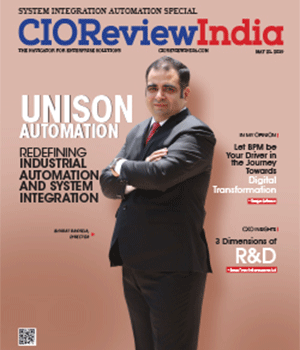
How has Automation proved to be a cost-effective solution for organizations
Ankit Gupta, CEO of WeblinkIndia.net | Tuesday, 09 April 2019, 05:48 IST
 Automation in the manufacturing industry has evolved from the creation of the assembly line by Henry Ford at his Highland Park plant, introduced on December 1, 1913, and revolutionized the working process of industry and the concept of manufacturing worldwide. The impact of the assembly line was revolutionary. Model –T resulted in less waste and a higher quality of the end product. In modern times, to stay ahead of the competition and realize continued success, regardless of one’s industry, business leaders are pressurised to find ways to reduce cost as much as possible. Automation provides the best way of doing so and also improves productivity and efficiency, which ultimately lead to higher profits. As per statista the global market for process automation is expected to grow to around 50.3 billion U.S. dollars by 2020.
Automation in the manufacturing industry has evolved from the creation of the assembly line by Henry Ford at his Highland Park plant, introduced on December 1, 1913, and revolutionized the working process of industry and the concept of manufacturing worldwide. The impact of the assembly line was revolutionary. Model –T resulted in less waste and a higher quality of the end product. In modern times, to stay ahead of the competition and realize continued success, regardless of one’s industry, business leaders are pressurised to find ways to reduce cost as much as possible. Automation provides the best way of doing so and also improves productivity and efficiency, which ultimately lead to higher profits. As per statista the global market for process automation is expected to grow to around 50.3 billion U.S. dollars by 2020.
First, let's understand the concept behind automation. The automation technology ecosystem helps reimagine process designs and creates new ways of working. This technology drives autonomous decision making process, continuous method improvements and learned orchestration to help transform businesses and help them adapt to an ever-changing marketplace. The more refined the automation platform, the greater the workflows it will perform, thereby making it more impactful to both the IT(Information Technology) department and the business as a whole. And using automation the service industry can evolve independently to support continuous process improvements and help business leaders make smarter, more data-driven decisions.
Reduce the need to outsource work
Intelligent automation is poised to make a significant and lasting impact on the business world; as a result it'll reduce the necessity to outsource work. While outsourcing was once considered an effective way to manage costs while producing a high-level output, automation can make this practice all but obsolete in time. That's because it's even more practical and affordable than outsourcing. Rather than paying outside staff, all tasks will be moved in-house and handled electronically. Subsequently, this will reduce errors and enhance security. It also leads to better scalability.
Productivity
As an organization's technology needs grow, productivity becomes a bigger concern. Typically, as different business verticals are given tools to increase productivity and effectiveness, IT operations take a back seat. The proliferation of desktop productivity created substantial gains in the office and HR (Human Resource) verticals. But, rather than alleviating work for IT professionals within the back room, the spread of PCs has meant more tasks need to be accomplished.
Improved Accuracy
Over the long term, monetary returns by automating explicit processes will grow. Products will straightaway be manufactured to precise specifications, have far lower defects, and create a far more consistent product. Part cycle time decreases because of automation and leads to an efficient production line. Automated machines have no need to take breaks like regular staff; therefore they work at a faster rate and manufacture more products within the same space of time than people do. This efficiency extends to the size of the machines because they have a smaller footprint than manually operated machines, allowing space to be utilized more effectively.
Enhanced Data Capture
The data captured during manufacturing provides not only invaluable insights into improving practices but also helps maximize efficiency and control over machines. Automation of data entry tasks (such as forms processing) cannot solely reduce costs but also enhance operational efficiencies. This, in turn, facilitates insurers dramatically improving customer experience by facilitating quicker response times and needing fewer requests from customers to verify data.
Performance
Every company would love to have its enterprise perform like a thoroughbred but is likely to be overburdened with work. Even though automation technology becomes faster and less expensive every year, the demands on it always catch up and eventually exceed the capability of the automation process. That leaves heaps of industries to want to improve their system performance.
Cost-benefit
Every business faces pressure to grow profits. One way to do so is by reducing cost. But, reducing capabilities of automation negatively impacts the entire company. Automation is a better and more intelligent approach to cost reduction. The best way to lower costs is by increasing service to customer while consistently reducing prices. Management often overlooks this potential for savings. Most modern servers have a budget and the total cost of possession has been declining. Even so, the cost of the operating servers is often as high as 71% of the total cost of the server.
A lower cost is one of the main advantages of investing in automation, and is a factor that a growing number of factories are taking into consideration across the globe. Automation provides answers to a number of manufacturing issues while delivering tangible results to the bottom line. Delivering the best possible experience to customers starts during production and this exciting technology delivers that all important competitive edge.
There is work for everyone today and there will be work for everyone tomorrow, even in a future where automation is commonplace. However manufacturing and technology companies that don’t adopt some automation techniques today are less likely to remain competitive. Companies need to make an effort to understand how internal processes can be optimised with automation. This will require an understanding of processes and of course technical expertise. Technical expertise provided by online web solutions allow organizations to allocate resources better, lower costs, and manage data well. Web solutions may also help analyse which internal process may be automated.
When servicing clients, automation can be used to offer a superior customer experience because it facilitates understanding of client’s requirements. A client’s user experience is also enhanced using automated web solutions because they optimise searches. Of course when clients are happy they are likely to continue giving business. Hence mobile apps, online applications, and web solutions when powered by automation grant tremendous advantages to organizations. Organizations that adopt these technologies are likely to remain ahead of the curve in the future.
CIO Viewpoint
By Steve Brunker, CIO, LSI Industries
By Joel Austin, CIO, Oncor Electric Delivery
How Is IoT Emerging as Next Technology Mega...
By Prashanta Ghoshal, Director - IT Solutions, Geometric Ltd.
CXO Insights
Addressing the Challenges in Logistics Automation
By Janifha Evangeline
Digitalization - the critical enabler for...
By Rajesh Ramachandran, Global Chief Digital Officer - Process Automation & ABB Ability, ABB
Enterprise-wide Approach Needed for...











